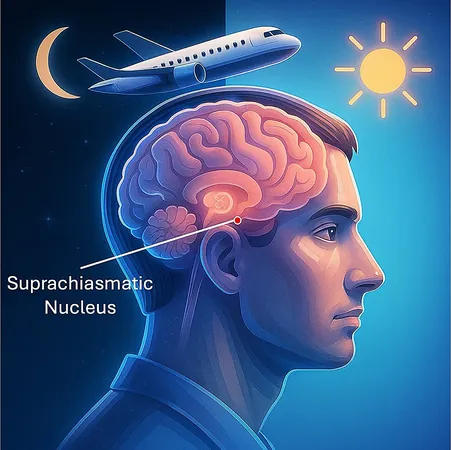
Unlocking the Secrets of Your Body's Clock: Groundbreaking Study Reveals the Complexity of Jet Lag Adjustment
2025-06-16
Author: Nur
A New Era in Circadian Research
In a groundbreaking study utilizing deep-brain imaging techniques on awake mice, researchers have unveiled the intricate mechanisms behind how light resets our circadian clock. This internal clock governs crucial life functions: when we sleep, eat, feel alert, and how our immune system responds to daily rhythms.
The Suprachiasmatic Nucleus: The Brain's Timekeeper
The body's circadian clock ticks aligned with a nearly 24-hour cycle, demanding a sophisticated system to synchronize it with the external light-dark environment. The key player in this process? The suprachiasmatic nucleus (SCN), a small region nestled deep within the hypothalamus, composed of 20,000 to 40,000 neurons that act like a central timing device.
Jet Lag: A Challenge for Modern Travelers
When we jet between time zones, the mismatch between our internal clock and the new locale leads to the notorious jet lag. Adjusting our internal timing—especially through exposure to varying light—is essential, yet the specific processes at work within the SCN have been a mystery until now.
Revolutionary Research Methodology
A recent article published in Nature Communications, led by teams from National Taiwan University (NTU) and National Tsing Hua University (NTHU), has made significant strides in understanding these mechanisms. Through advanced two-photon calcium imaging, researchers could observe the real-time responses of individual SCN neurons to light.
A Surprising Complexity Revealed
Dr. Po-Ting Yeh, the lead researcher of the study, explains that previous assumptions depicted the SCN's resetting as a straightforward reflex action. However, findings indicate a multifaceted network. Instead of a simple relay of signals, some neurons are activated while others are inhibited, presenting a nuanced balance rather than a linear cascade.
Harnessing Neuronal Power for Potential Solutions
Using genetic tools, researchers identified a specific group of SCN neurons that are activated by light late in the evening to delay the body clock. Interestingly, when researchers artificially stimulated these neurons at any time, even during the day when the body typically ignores light, they could effectively shift the mouse's internal clock.
Looking to the Future of Sleep Science
Future implications of this research are exciting. Controlling these neurons could expedite recovery from jet lag or assist late-night owls in rising on time for early commitments. As Professor Shih-Kuo Chen, the senior author, notes, understanding how external cues like light integrate into our body's functions could pave the way for innovative treatments for sleep disorders, including jet lag and insomnia.
A New Understanding of Our Biological Rhythms
This study not only disrupts long-standing beliefs about the brain's central clock but also opens new avenues for therapies that align with our natural rhythms. As we unlock these secrets, we move closer to enhancing our daily lives through a deeper understanding of how we can better synchronize with the world around us.


 Brasil (PT)
Brasil (PT)
 Canada (EN)
Canada (EN)
 Chile (ES)
Chile (ES)
 Česko (CS)
Česko (CS)
 대한민국 (KO)
대한민국 (KO)
 España (ES)
España (ES)
 France (FR)
France (FR)
 Hong Kong (EN)
Hong Kong (EN)
 Italia (IT)
Italia (IT)
 日本 (JA)
日本 (JA)
 Magyarország (HU)
Magyarország (HU)
 Norge (NO)
Norge (NO)
 Polska (PL)
Polska (PL)
 Schweiz (DE)
Schweiz (DE)
 Singapore (EN)
Singapore (EN)
 Sverige (SV)
Sverige (SV)
 Suomi (FI)
Suomi (FI)
 Türkiye (TR)
Türkiye (TR)
 الإمارات العربية المتحدة (AR)
الإمارات العربية المتحدة (AR)